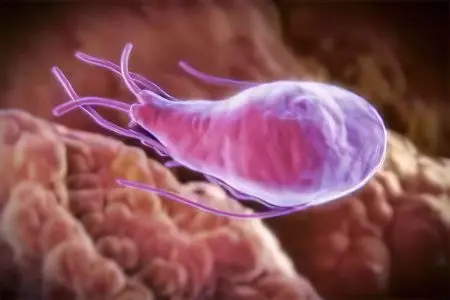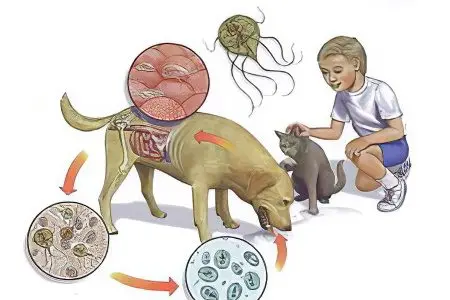Contents
What is giardiasis?

Giardiasis is an invasive disease caused by protozoan parasites and characterized by damage to the small intestine. The main manifestations of giardiasis are allergic and pathological neurological reactions.
The causative agent of giardiasis is the simplest flagellar microorganism – giardia (Giardia). Modern science knows about 40 varieties of Giardia, but only Lamblia interstinalis parasitizes in the human intestine.
This protozoan microorganism exists in the form of cysts and in the form of vegetations. Vegetative Giardia has a pear-shaped shape, somewhat reminiscent of a human face with a forced smile. Giardia do not reach more than 24 microns in length, and 12 microns in width, so they are visible only under a microscope.
On the ventral side of the parasite there is a suction disk, which is used to attach to the villi lining the human intestine. Giardia feed on the entire surface of the body, absorbing the substances they need for life.
In the form of vegetation, Giardia move very actively. Flagella help them in this, the parasite has 4 pairs of them. Outside the human body, vegetative forms are incapable of long-term existence and die within a few hours.
After the parasites enter the human intestine, Giardia begins to divide, forming a new vegetation and a cyst. The cysts come out with the patient’s feces. Unlike vegetations, cysts have good resistance in the environment. They retain their viability without a human body for 18 days or more in water, and with sufficient humidity they live for about 4 days. Cysts do not respond to chlorine treatment, but do not tolerate drought. Without adequate moisture, the cysts die within a few hours.
Giardia lead an independent lifestyle, fully providing for their needs at the expense of the host organism. Giardiasis is ubiquitous. Most carriers of this protozoan infection live in Latin America, Africa and Central Asia. For the first time, the causative agent of the disease was discovered in human feces in 1684 by Anthony van Leeuwenhoek, and the scientist D. F. Lambl described the parasite in detail in 1859. This microorganism was named after him.
Animals, along with humans, are susceptible to giardiasis. This parasitic infestation is found in rabbits, dogs, cats, rodents, cattle and other mammals. A person most often becomes infected from another person who releases Giardia cysts into the external environment, but the possibility of infection from animals is not ruled out.
Already 9-22 days after the primary invasion, a person becomes dangerous to others, as with feces, he begins to release cysts of parasites ready for infection into the external environment. Just 1 g of feces can contain 23 million cysts of parasites, but the average number of cysts per 1 g of feces is 1,8 million. At the same time, in order for infection to occur, from 1 to 10 cysts can enter the human gastrointestinal tract. Under such conditions, the risk of invasion will fluctuate between 10-30%.
giardiasis statistics

More than 140 thousand cases of giardiasis are registered in Russia every year. The number of adults from this figure is about 30%. The disease is dangerous primarily because it has an asymptomatic course, and the clinical signs that occur in an adult are not specific. Often, giardiasis is hidden under the mask of biliary dyskinesia, under chronic enteritis and other pathologies of the digestive tract.
The mechanism of transmission of parasitic infection is fecal-oral. Ways of transmission – through the hands, through water, through food contaminated with parasite cysts. Giardia cysts can be carried by some insects, in particular, flies.
The prevalence of giardiasis is explained by the high contamination by cysts of parasites of most objects of the external environment:
There are from 1 to 4 cysts per 30 cubic meter of water in open reservoirs.
For 1 liter of wastewater that has not been treated, there are up to 1091 cysts.
There are from 1 to 10 cysts per 35 liter of treated wastewater that will be discharged into open water bodies.
There are up to 1 cysts per 112 kg of soil in PEIs located in non-canalized settlements (in 11-22% of all studied soils).
In 6% of cases, cysts were found in swabs from doorknobs in kindergartens, in 3% in swabs from children’s hands, in 2% in swabs from children’s pots, and in 0,2% in swabs from toys.
Cysts remain viable in water from 15 to 70 days, in feces they live from 2 hours to a day. If cysts enter open water bodies, then at temperatures from 2 to 22 ° C they can live for about 3 months. In the sea, cysts retain the ability to invade for 47 days.
However, cysts are not resistant to heat and when boiled, they die instantly. As for food, the cysts of the parasite can survive on fruits for 6 hours, in dairy products they can live up to 12 days, and sometimes up to 112 days.
In different countries around the world, outbreaks of giardiasis have been reported due to drinking untreated water that has not been properly treated at waterworks. For example, a similar situation was observed in America, in Egypt, in Sweden.
In most preschools, children become infected through dirty hands. The source of the spread of giardiasis are other children, as well as staff.
Do not exclude the possibility of infection with parasites through food. Cysts can get on prepared foods from the hands of those people who have been in contact with them. Or infection occurs when eating poorly processed fruits, vegetables, herbs, etc.
Causes of infection with giardiasis

Giardiasis is caused by an intestinal parasite called Lamblia intestinalis.
Giardia breed in the human small intestine, in those places where they accumulate the most. The method of reproduction is continuous pair division of vegetative individuals. The speed of this process is very high and averages 20 minutes; as a result, the intestines are colonized by parasites rather quickly.
The activity of Giardia and the rate of their reproduction directly depends on the state of the human digestive organs. The number of individuals sharply decreases during fasting and when the patient consumes a sufficient amount of protein food. When carbohydrate food enters the body, on the contrary, there is an insufficient secretion of bile into the intestinal lumen, which stimulates the growth and reproduction of parasites.
The more active the processes of parietal digestion in the intestine, the faster Giardia begin to divide, which explains the high prevalence of invasion among children, compared with the adult population. Favorable conditions for the existence of the parasite in the intestine is the reduced acidity of gastric juice.
The source of infection is always a sick person. Moreover, he himself can be a carrier of Giardia, and he will not experience symptoms of the disease at all. A person becomes contagious approximately 8-12 days after the invasion. The incubation period in some cases may be shorter, especially with a massive infection with Giardia.
Cysts are released into the external environment in waves. The pause between this process can be from 1 to 17 days. If a person was infected once, and subsequent reinfection does not occur, then he will remain contagious for 6 months.
From the point of view of maximum contagiousness, the most dangerous is the patient whose symptoms of giardiasis have subsided. During this period, intestinal peristalsis normalizes, and favorable conditions are created for the reproduction of parasites.
One gram of feces can contain about 1,8 million cysts capable of invasion. And in order for infection to occur, it is enough to swallow only 10 cysts.
Giardia transmission mechanism is fecal-oral. Ways of spread of infection: food, contact-household and water.
Most often, the water way of spreading giardiasis leads to massive outbreaks of infection. It is not excluded infection during a visit to the pool, when swimming in open water. Giardiasis can be transmitted by eating foods contaminated with parasite cysts. Cases of infection during sexual contact between male homosexuals are known.
There is a high risk of transmission of giardiasis under the following conditions:

Non-observance of personal hygiene. First of all, this concerns poor-quality and untimely washing of hands after visiting public places, the toilet and before eating.
Poor processing of food that is eaten raw.
Drinking unboiled water, especially from open natural sources. Giardia can be present in any water, including spring water.
Poor sanitary living conditions, the presence of insects in the house. Of particular danger in this regard are flies and cockroaches, which are the spreaders of the infection.
Infection with giardiasis from infested animals is possible: dogs, guinea pigs, cats, etc.
Adults of the following professions are more susceptible to invasion:
Employees of educational institutions (kindergartens, schools).
Medical workers (laboratory assistants).
Sump trucks.
Risk factors for giardiasis in adults:
A large amount of carbohydrate food in the diet.
Insufficient consumption of protein foods and foods with vegetable fiber (vegetables, fruits, cereals).
Decreased acidity of the stomach.
Violation of the immune system.
Long-term treatment with antibacterial drugs, which leads to excessive bacterial growth in the intestine. Such an environment is favorable for the existence of lamblia.
Addiction.

In the Russian Federation, the disease is most often recorded in spring (April and May), as well as in summer. The least cases of giardiasis are observed in November and October.
For many years, the danger of giardiasis was significantly underestimated. Modern scientists have no doubts that parasites are a threat to human health. Therefore, lamblia in adults must be diagnosed and treated in a timely manner.
The entrance gate for parasites is the upper sections of the small intestine. There, mature cysts lose their protective shell and become vegetative individuals. One cyst produces 2 trophozites. With the help of flagella, they move along the intestinal mucosa, finding themselves comfortable conditions for existence.
After attaching to the intestinal villi, the vegetative forms begin to divide. Colonization of the organ occurs very quickly. Only one square centimeter of the intestine can contain up to 1 ml of individuals. The maximum number of Giardia occurs in the upper part of the small intestine. It is here that parasites have optimal conditions for access to the spaces between the villi, from which they absorb carbohydrates, fats, proteins, mineral salts and other nutrients. In later periods, Giardia descend into the middle and final sections of the small intestine.
Those vegetative forms of Giardia that are not attached to the villi descend into the large intestine, where they become cysts. After that, the cysts absorb the flagella and become covered with a protective sheath. This process is maximally facilitated under the condition of normal intestinal motility. If it is accelerated, which is observed with diarrhea, the vegetative forms of Giardia do not have enough time to form full-fledged cysts, and they go out into the environment insufficiently protected. As it was said, such vegetations die very quickly outside the human body.
For a long time there was confidence that Giardia is able to parasitize in the bile ducts. However, it has been proven that bile in high concentrations is detrimental to these parasites. They lose viability in it in a few seconds.
Factors that contribute to mass outbreaks of giardiasis among the population are:
Fecal pollution of the environment;
High crowding of people;
Low level of formation of sanitary and hygienic skills among the population;
Insufficient or poor-quality sedum of drinking water before it enters the water supply system.
Naturally, the risks of invasion for an adult increase if one or more children under the age of 10 live in the house.
Are giardia transmitted?

Can Giardia be transmitted from person to person? Giardia is transmitted from person to person.
Are Giardia transmitted through a kiss, saliva? The transmission of Giardia through a kiss is theoretically possible, provided that parasite cysts are present in the saliva of a person during the kiss.
Can Giardia be transmitted from cats to humans? Giardia transmission from cats to humans is possible.
Can you see Giardia in stool? It is impossible to see Giardia in the feces on your own, since their size is very small. Therefore, parasites in stool can only be visualized under a microscope.
Symptoms of giardiasis

Symptoms of giardiasis are very often absent altogether. Asymptomatic course of the disease is observed in 65% of patients. If the clinical picture manifests itself brightly, then most often this is associated either with a massive invasion, or with a disruption in the functioning of the human immune system, or with the ingestion of individual strains of infection with high virulence into the body. For example, in people with HIV, the disease is much more severe than in healthy patients. Periods of remission are replaced by frequent periods of exacerbation.
The following classification of giardiasis is considered to be the most complete:
Asymptomatic carriage of giardiasis
Severe symptoms of giardiasis. Significant symptoms of the disease include:
Intestinal damage with enteritis, enterocolitis, duodenitis and duodenal dyskinesia (intestinal form of the disease).
Hepatobiliary form in which the symptoms of cholecystitis and biliary dyskinesia come to the fore.
Giardiasis as a concomitant disease.
Based on the study of the symptoms of giardiasis in people of different age groups, Zalipaeva T. L. identified the following main syndromes of the disease:
Dyspeptic syndrome, which is the leading one and is present in the clinical picture of 81,5% of all patients.
Pain syndrome, which is inherent in 76,9% of all infected.
Astheno-neurotic syndrome with increased fatigue, irritability and headaches. Similar symptoms are observed in 64,8% of patients.
Allergic reactions of the body. Most often, patients have atopic dermatitis. This syndrome occurs in 15,7% of cases.
It was noted that such syndromes may be present in any of the listed clinical forms of giardiasis. As for laboratory data, with giardiasis in 31,5% of patients there is an increase in the number of eosinophils by 5-7%.
Symptoms of giardiasis in the acute stage

The following symptoms are characteristic of the acute stage of giardiasis:
Nausea, lack of appetite, frequent belching.
Bloating, flatulence, rumbling in the intestines, profuse gas separation.
Weight loss.
In the area of the right hypochondrium and in the umbilical zone, painful sensations arise. At the same time, pain in the navel region is noted by every second patient, and about 15% of people indicate pain in the right hypochondrium. Painful sensations are very often associated with eating, so they are not associated with giardiasis.
A bitter or sour taste appears in the mouth.
Diarrhea may develop. In this case, the chair becomes quickened, it can happen from 3 to 5 times a day. If at the beginning of the acute period the character of the stool is liquid and watery, then later it thickens and becomes oily.
Increased salivation.
There is rapid fatigue and unexplained weakness.
Performance deteriorates.
Skin rashes appear.
Avitaminosis. Its symptoms are reduced to increased fragility of nails, hair loss, peeling of the skin, etc.
The acute period lasts for five days, but sometimes it can stretch for a week. If a person has an immunodeficiency, then the acute period of giardiasis is usually longer, and all of the listed symptoms are fully manifested.
Sometimes in the acute phase there are symptoms of biliary dyskinesia. If in children with giardiasis the body temperature rises and the symptoms of intoxication increase, then for adult patients such a clinical picture is not typical.
A week later, giardiasis either resolves on its own or becomes chronic.
Symptoms of giardiasis in the chronic stage

Symptoms indicating a chronic form of giardiasis in adults:
Disorders of the digestive system. The patient’s stool becomes unstable, frequent constipation is replaced by the same frequent diarrhea. Appetite remains reduced, periodically disturbed by swelling and rumbling in the intestines.
The general well-being of a person suffers. Headaches are often disturbed, excessive drowsiness and irritability appear. This condition leads to poor performance.
Skin color worsens, mild jaundice may develop. First of all, the neck, face, axillary folds, and abdomen acquire an icteric hue.
Skin rashes begin to disturb the patient more and more often, even if the person did not suffer from allergies before. Possible phenomena of dermatitis or urticaria. Quincke’s edema in adulthood against the background of giardiasis is extremely rare, more often asthmatic bronchitis or bronchial asthma develops. The main features of allergies against the background of giardiasis are: a long course, no response to taking antihistamines, frequent relapses.
Urticaria is especially difficult against the background of giardiasis in adults, violating the quality of life of the patient. Moreover, it occurs without any background errors in nutrition, without taking medications, etc. Very often, urticaria is accompanied by blepharitis.
For chronic giardiasis, follicular keratosis is characteristic with the appearance of pinpoint swelling on the skin. The skin of the shoulders is predominantly affected. It is covered with a rough crust or white rounded plaques, prone to increased peeling.
Xerosis is associated with giardiasis, in which the patient’s heels peel off, especially in the cold season.
An isolated lesion of the palms and feet is possible, when the skin begins to peel off the tips of the phalanges. Fingers look like old ones. This process, as a rule, does not reach the palms.
The mucous membrane of the oral cavity suffers. A person often develops aphthous stomatitis, seizures appear in the corners of the mouth, the border of the lips becomes inflamed.
Hair thins, becomes brittle, loses its natural shine.
The patient continues to lose weight.
If Giardia in an adult parasitizes for a long time, then there will be signs of immunosuppression and symptoms of intoxication. At the same time, the lymph nodes periodically become inflamed, the tonsils increase, the body temperature rises to subfebrile marks.
Another indirect sign of giardiasis in adults is intolerance to whole cow’s milk, as these parasites infect enterocytes responsible for the hydrolysis of carbohydrate food components. This also explains the increased gas formation in the intestines.
The consequences of giardiasis

The consequences of giardiasis occur with a long course of the disease. First of all, the human immune system suffers, which provokes permanent viral and bacterial diseases.
Secondly, the risks of developing chronic diseases of the digestive system increase, from which it will be impossible to get rid of even after curing giardiasis. Perhaps the development of acute pancreatitis, cholecystitis, gastroduodenitis, ulcerative lesions of the stomach and intestines.
Thirdly, with parasitic invasion, the patient suffers from allergic reactions that can result in bronchial asthma. Its symptoms can also persist throughout life, even if giardiasis is cured.
Diagnostics
Diagnosis of lamblia in adults must be carried out without fail according to the following indications:

Diarrhea that is persistent and does not find viral, autoimmune or bacterial confirmation.
Allergic and allergic-like diseases of the respiratory tract (bronchial asthma, obstructive bronchitis) and skin (urticaria, eczema, dermatitis, etc.).
An increase in eosinophils in the blood.
Prolonged increase in body temperature to subfebrile levels.
Having confirmed contact with an infected person.
Visual markers of patients with giardiasis are: dry skin, mesogastric pain, bloating, furred tongue, possibly an increase in liver size.
Modern diagnosis of Giardia in adults includes the following set of possible measures:
Microscopic examination of feces.
PCR cal.
ELISA feces using rapid tests.
PCR duodenal contents of the duodenum.
ELISA of blood for giardiasis.
The basic diagnostic method is microscopic examination of feces. It must be carried out at least 3 times, especially if there is a suspicion of the presence of parasites in the human body. Most often, Giardia cysts are found in the feces.
For the result to be as reliable as possible, the following conditions must be met:
On the eve of the test, it is advisable to refuse to take roughage, mushrooms and liver, so as not to impede the visualization of parasites;
Do not use an enema to collect biomaterial;
Refuse to take sorbents and antibiotics, or wait 2 weeks after the last dose of the drug;
Feces are collected in a sterile container;
The feces must be fresh, it must be delivered to the laboratory within an hour.
Additional methods for diagnosing giardiasis in adults can be such studies as: a general blood and urine test, blood biochemistry, a coprogram and stool culture for microflora, a test for lactase deficiency, FGDS, etc.
Treatment of giardiasis in adults

Treatment of lamblia in adults is carried out by an infectious disease doctor.
Before deciding on therapy, the doctor must consider such aspects as:
The severity of the symptoms of the disease;
The duration of the presence of lamblia in the intestine;
Presence of comorbidities.
It is equally important to try to determine the source of the invasion in order to prevent reinfection. You should not start treatment with taking antiprotozoal drugs, as this will exacerbate the symptoms of the disease and may provoke a reactive response of the body.
Therefore, the treatment of lamblia in adults is carried out in stages:
Preparatory stage before the treatment of giardiasis. At the preparatory stage, it is necessary to try to mechanically remove the maximum number of lamblia from the intestines, as well as remove intoxication from the body. During this time, the patient must adhere to a dietary diet.
To do this, the patient must comply with the following recommendations:
Completely exclude sweets and carbohydrates from the menu, which are quickly absorbed;
Eat foods rich in fiber;
Eat protein foods;
Refuse whole milk, limit the intake of fats;
Eat according to the regime, switch to fractional meals (5-6 times a day);
Drink more liquid, giving preference to sour fruit drinks and choleretic decoctions.
The addition of the diet is the intake of enterosorbents, choleretic drugs, antihistamines and digestive enzymes. Thus, conditions unfavorable for the reproduction of parasites will be created in the intestines and the rate of their division will decrease significantly.
The use of antiparasitic agents against lamblia. The second stage of antiparasitic therapy takes 5-10 days.
Recovery of the body after the treatment of giardiasis. The final stage of treatment is aimed at increasing the patient’s immunity, at normalizing the intestinal microflora. To do this, he is prescribed vitamin-mineral complexes, intestinal bacteria, enzyme preparations.
As a rule, the prognosis for giardiasis in adults is quite favorable. In the event that the patient strictly fulfills all the appointments of the attending doctor, recovery is observed in 92-95% of cases. However, reinfection is not excluded, so the patient should remain at the dispensary for another 3-6 months. During this time, it must be examined at least 2 times.
Giardia prevention in adults

Giardia prevention in adults is reduced to the following measures:
Timely detection of cases of invasion with subsequent high-quality treatment of patients with giardiasis.
Following strict hygiene rules with regular handwashing.
Use for drinking boiled or bottled water.
Prevention of fecal matter from entering the environment.
Compliance with sanitary and hygienic measures in food and water supply establishments.
Regular examination of persons at risk for giardiasis.
Conducting sanitary-educational work among the population by local authorities.
There is no vaccine for giardiasis, and the immunity that is developed after an illness is not very stable. Therefore, the risk of reinvasion remains high.
Which doctor treats giardiasis?
Giardiasis is treated by an infectious disease specialist.









